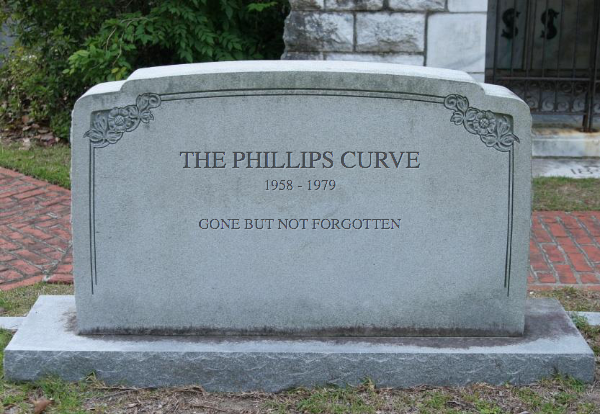Revenge of the Zombies
The debate over the Phillips curve is back at the forefront of the macroeconomics profession. But despite all the fire and fury it has generated in the economics blogosphere, the case for it is no stronger than it was 50 years ago.
As a quick refresher, the Phillips curve famously postulated an inverse relationship between inflation and unemployment. It rose to prominence in the 1960s, when empirical evidence seemed to indicate such a relationship.
The rationale behind the Phillips curve as well as the empirical evidence supporting it was undermined with the stagflation of the 1970s and early 1980s. The natural-rate hypothesis, expounded by the likes of Milton Friedman, Robert Lucas, and Edmund Phelps, replaced it in the canon of macroeconomics. It held that unexpectedly high inflation might temporarilypush the unemployment rate down, as the reduction in workers’ real wages enables firms to hire more workers. But over time, as workers update their expectations of future inflation, this relationship disappears. When workers come to expect high inflation to continue, they demand higher nominal wages, raising their real wages and forcing employees to cut back on their hiring. As a result, unemployment returns to its long-run, or “natural,” rate. In short, if workers have “rational expectations” there should be no long-run tradeoff between inflation and unemployment. Phelps was eventually rewarded for his compelling rejection of the Phillips curve with the 2006 Nobel Prize in economics. But over the next decade, the lingering effects of the Great Recession on labor markets returned the seemingly dead Phillips curve to the limelight.
In a series of recent articles, Paul Krugman, Olivier Blanchard, and Mike Konczal have argued that the natural-rate hypothesis should be reconsidered. In particular, they argue that the coexistence of extraordinary low unemployment (3.9 percent in April) and relatively low inflation (approximately 2 percent in March, right at the Fed’s implicit target) has undermined Friedman’s notion (closely associated with the natural rate) of the non-accelerating inflation rate of unemployment (NAIRU), the rate of unemployment required to keep the inflation rate constant. If the NAIRU hypothesis holds true, they contend, we should expect to see inflation rise well above 2 percent because the actual unemployment rate of 3.9 percent is well below the estimated natural rate of unemployment, typically assumed to be between 5 and 6 percent.
Is the natural-rate hypothesis dead, and has the Phillips curve been resurrected? No, and no. It’s true that unemployment is low by historical standards. But that alone doesn’t imply it has dipped below the natural rate of unemployment (or, equivalently, the NAIRU). Economists have long acknowledged that it is very difficult to estimate the natural rate of unemployment with any precision. Looking at the unemployment rate in isolation likely isn’t the best way to determine whether the economy is overheated — nor is looking solely at inflation, since rising or falling prices might be a sign of a negative or positive real shock rather than an over- or underheated economy.
A better way to assess whether the economy in general and the labor market in particular are overheating is to look at some measure of total spending, or aggregate demand. According to that metric, the economy doesn’t appear to be overheating. Nominal GDP (or final sales to domestic purchasers, which I believe does a better job of capturing domestic demand for final output) has consistently remained below its pre-crisis annual growth trend of 5 percent. Recently it has risen closer to that 5 percent benchmark, but so far there are no signs that the economy has overheated or that labor markets are operating beyond full employment.
None of this is to say the economy isn’t on the verge of overheating, or that there aren’t deep structural problems in labor and capital markets that have caused our factors of production to be misallocated. All of these possible real-side problems might, indeed, be genuine and very significant. My point here is simply that when we restrict our focus to the nominal factors the Fed actually does have relatively strong control over, there don’t appear to be any flashing red lights that would indicate that the unemployment rate is below the NAIRU or that we should throw the entire notion of the natural rate out.
A key mistake many critics of the NAIRU hypothesis have made over the past few weeks is getting the causation between inflation and unemployment entirely wrong. Low unemployment doesn’t cause inflation. Nor does (price) inflation cause low unemployment. The monetary-equilibrium framework provides a better lens to view the relationship between money, total spending, inflation, and unemployment than the old-fashioned Phillips curve. In this framework, price inflation arises when there is an excess supply of money relative to the demand to hold it at the existing price level. Because many prices are sticky (particularly input prices such as wages, since most labor contracts are set over extended periods of time), this excess supply of money will temporarily raise aggregate demand and output prices. This, in turn, will reduce real wages in the economy, incentivizing firms to increase their hiring, which ultimately causes the unemployment rate to fall.
It’s essential to stress that this reduction in the unemployment rate doesn’t cause the inflation. Rather, it is the excess supply of money that causes total spending and inflation to rise above their historical trends and, in turn, reduces real wages and prompts a decline in the unemployment rate. Placing labor markets at the front of this process places the cart before the horse. It also wrongly attributes inflation to “cost push” factors rather than “demand pull” factors such as overly expansionary monetary policy.
Roger Garrison refers to Keynesian macroeconomics as “labor-based macroeconomics” because of its acute focus on labor markets. If we truly want to explain the relationship between inflation and unemployment, as the Phillips curve purports to do, we need to look beyond labor markets to money and output markets. When we do, we see that some of the alleged deficiencies of the natural-rate hypothesis aren’t really deficiencies at all. Policy makers can prevent unemployment from rising above its natural level by maintaining monetary equilibrium, but they don’t control any magic levers that enable the economy to produce beyond its sustainable level of output in the long run.
On his blog, Krugman regularly refers to “zombie ideas,” policy ideas that keep being killed by evidence but nonetheless shamble relentlessly forward because they serve some ideological agenda. In this case, Krugman’s own flawed model has caused him and many other Keynesians to fall prey to the zombie of the Phillips curve.











